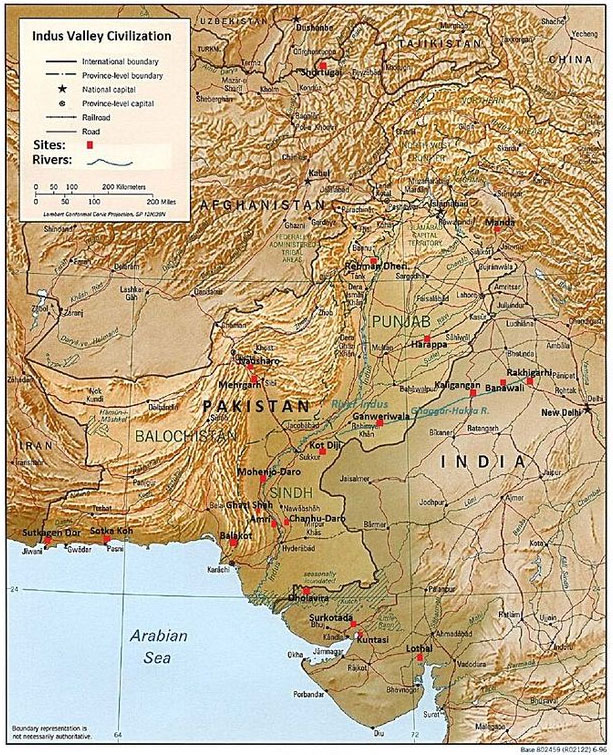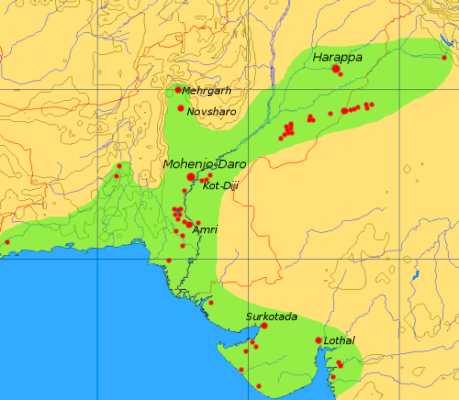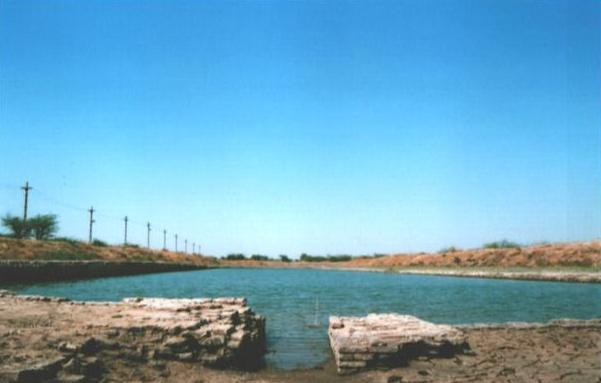Indus Valley Civilisation
Blogs Home
- 06 May 2022
.png)
“If civilization is to survive, we must cultivate the science of human relationships - the ability of all peoples, of all kinds, to live together, in the same world at peace.” – Franklin D. Roosevelt
Indus civilization, also known as the Indus valley Civilisationor Harappan civilization, is the earliest known urban culture of the Indian subcontinent. The nuclear dates of the Civilisation appear to be about 2500–1700 BCE, though the southern sites may have lasted later into the 2nd millennium BCE. Among the world’s three earliest civilizations—the other two are those of Mesopotamia and Egypt—the Indus Civilisationwas the most extensive.
Indus Valley Civilisation
The Indus Valley Civilisation existed through its early years of 3300-1300 BCE, and its mature period of 2600-1900 BCE. The area of this Civilisation extended along the Indus River from what today is northeast Afghanistan, into Pakistan and northwest India.
The Indus Civilisation was the most widespread of the three early civilizations of the ancient world, along with Ancient Egypt and Mesopotamia. Harappa and Mohenjo-Daro were thought to be the two great cities of the Indus Valley Civilization, emerging around 2600 BCE along the Indus River Valley in the Sindh and Punjab provinces of Pakistan. Their discovery and excavation in the 19th and 20th centuries provided important archaeological data about ancient cultures.
Chronology
Sir Mortimer Wheeler, British archaeologist who is noted for his discoveries in Great Britain and India and for his advancement of scientific method in archaeology. After serving in World War II, Wheeler was made director general of archaeology for the government of India (1944–47), where his research focused on the origins and development of the Indus civilization.
Wheeler's work provided archaeologists with the means to recognize approximate dates from the civilization's foundations through its decline and fall. The chronology is primarily based, as noted, on physical evidence from Harappan sites but also from knowledge of their trade contacts with Egypt and Mesopotamia.
Lapis Lazuli was the only product that was immensely popular in both cultures and, although scholars knew it came from India, they did not know from precisely where until the Indus Valley Civilisation was discovered. Even though this semi-precious stone would continue to be imported after the fall of the Indus Valley Civilization, it is clear that, initially, some of the export came from this region. Various regions emerged at different phases of the Harappan civilisation, which projected a chronology of human advancement. These phases can be categorised as follows:
- Pre-Harappan – c. 7000 - c. 5500 BCE: The Neolithic period best exemplified by sites like Mehrgarh which shows evidence of agricultural development, domestication of plants and animals, and production of tools and ceramics.
- Early Harappan – c. 5500-2800 BCE: Trade firmly established with Egypt, Mesopotamia, and possibly China. Ports, docks, and warehouses were built near waterways by communities living in small villages.
- Mature Harappan – c. 2800 - c. 1900 BCE: Construction of the great cities and widespread urbanisation. Harappa and Mohenjo-Daro are both flourishing c. 2600 BCE. Other cities, such as Ganeriwala, Lothal, and Dholavira are built according to the same models and this development of the land continues with the construction of hundreds of other cities until there are over 1,000 of them throughout the land in every direction.
- Late Harappan – c. 1900 - c. 1500 BCE: Decline of the Civilisation coinciding with a wave of migration of the Aryan people from the north, most likely the Iranian Plateau. Physical evidence suggests climate change caused flooding, drought, and famine. A loss of trade relations with Egypt and Mesopotamia has also been suggested as a contributing cause.
- Post-Harappan – c. 1500 - c. 600 BCE: The cities were abandoned, and the people had moved south. The Civilisation had already fallen by the time Cyrus II (the Great, r.c. 550-530 BCE) invaded India in 530 BCE.
Discovery & Early Excavation
The story of the Indus Valley Civilization, therefore, is best given with the discovery of its ruins in the 19th century CE.
James Lewis (better known as Charles Masson, l. 1800-1853 CE) was a British soldier serving in the artillery of the East India Company Army when, in 1827 CE, he deserted with another soldier. In order to avoid detection by authorities, he changed his name to Charles Masson and embarked on a series of travels throughout India. Masson was an avid numismatist (coin collector) who was especially interested in old coins and, following various leads, wound up excavating ancient sites on his own. One of these sites was Harappa, which he found in 1829 CE. He seems to have left the site fairly quickly, after making a record of it in his notes but, having no knowledge of who could have built the city, wrongly attributed it to Alexander the Great during his campaigns in India c. 326 BCE.
When Masson returned to Britain after his adventures (and having been somehow forgiven for desertion), he published his book Narrative of Various Journeys in Balochistan, Afghanistan and Punjab in 1842 CE which attracted the attention of the British authorities in India and, especially, Alexander Cunningham. Sir Alexander Cunningham (l. 1814-1893 CE), a British engineer in the country with a passion for ancient history, founded the Archaeological Survey of India (ASI) in 1861 CE, an organisation dedicated to maintaining a professional standard of excavation and preservation of historic sites. Cunningham began excavations of the site and published his interpretation in 1875 CE (in which he identified and named the Indus Script) but this was incomplete and lacked definition because Harappa remained isolated with no connection to any known past Civilisation which could have built it.
In 1904 CE, a new director of the ASI was appointed, John Marshall (l. 1876-1958 CE), who later visited Harappa and concluded the site represented an ancient Civilisation previously unknown. He ordered the site to be fully excavated and, at about the same time, heard of another site some miles away which the local people referred to as Mohenjo-Daro (“the mound of the dead'') because of bones, both animal and human, found there along with various artefacts. Excavations at Mohenjo-Daro began in the 1924-1925 season and the similarities of the two sites were recognized; the Indus Valley Civilisation had been discovered.
In 1912, John Faithfull Fleet, an English civil servant working with the Indian Civil Services, discovered several Harappan seals. This prompted an excavation campaign from 1921-1922 by Sir John Hubert Marshall, Director-General of the Archaeological Survey of India, which resulted in the discovery of Harappa. By 1931, much of Mohenjo-Daro had been excavated, while the next director of the Archaeological Survey of India, Sir Mortimer Wheeler, led additional excavations.
The Partition of India, in 1947, divided the country to create the new nation of Pakistan. The bulk of the archaeological finds that followed was inherited by Pakistan. By 1999, over 1,056 cities and settlements had been found, of which 96 have been excavated.
Cities of the Indus Valley Civilization
The Indus Valley Civilisation (IVC) contained urban centres with well-conceived and organised infrastructure, architecture, and systems of governance.
By 2600 BCE, the small Early Harappan communities had become large urban centres. These cities include Harappa, Ganeriwala, and Mohenjo-Daro in modern-day Pakistan, and Dholavira, Kalibangan, Rakhigarhi, Rupar and Lothal in modern-day India. In total, more than 1,052 cities and settlements have been found, mainly in the general region of the Indus River and its tributaries. The population of the Indus Valley Civilisation may have once been as large as five million.
The remains of the Indus Valley Civilisation cities indicate remarkable organisation; there were well-ordered wastewater drainage and trash collection systems, and even public granaries and baths. Most city-dwellers were artisans and merchants grouped in distinct neighbourhoods. The quality of urban planning suggests efficient municipal governments that placed a high priority on hygiene and religious rituals.
Society and Political System
Archaeological records provide no immediate answers regarding a centre of authority or depictions of people in power in Harappan society. The extraordinary uniformity of Harappan artefacts is evident in pottery, seals, weights, and bricks with standardised sizes and weights, suggesting some form of authority and governance.
Over time, three major theories have developed concerning Harappan governance or system of rule.
The first is that there was a single state encompassing all the communities of the civilization, given the similarity in artefacts, the evidence of planned settlements, the standardised ratio of brick size, and the apparent establishment of settlements near sources of raw material.
The second theory posits that there was no single ruler, but a number of them representing each of the urban centres, including Mohenjo-Daro, Harappa, and other communities.
Finally, experts have theorised that the Indus Valley Civilisation had no rulers as we understand the concept of a ruler today, with everyone enjoying equal status.
Craft, Technology and Artefacts
The Indus Valley Civilisation is the earliest known culture of the Indian subcontinent of the kind now called “urban” (or centred on large municipalities), and the largest of the four ancient civilizations, which also included Egypt, Mesopotamia, and China. The society of the Indus River Valley has been dated from the Bronze Age, the period from approximately 3300-1300 BCE. It was located in modern-day India and Pakistan and covered an area as large as Western Europe.
Harappa and Mohenjo-Daro were the two great cities of the Indus Valley Civilization, emerging around 2600 BCE along the Indus River Valley in the Sindh and Punjab provinces of Pakistan. Their discovery and excavation in the 19th and 20th centuries provided important archaeological data regarding the civilization’s technology, art, trade, transportation, writing, and religion.
Technology
The people of the Indus Valley achieved many notable advances in technology, including great accuracy in their systems and tools for measuring length and mass.
Harappans were among the first to develop a system of uniform weights and measures that conformed to a successive scale. The smallest division, approximately 1.6 mm, was marked on an ivory scale found in Lothal, a prominent Indus Valley city in the modern Indian state of Gujarat. It stands as the smallest division ever recorded on a Bronze Age scale. Another indication of an advanced measurement system is the fact that the bricks used to build Indus cities were uniform in size.
Harappans demonstrated advanced architecture with dockyards, granaries, warehouses, brick platforms, and protective walls. The ancient Indus systems of sewerage and drainage developed and used in cities throughout the region were far more advanced than any found in contemporary urban sites in the Middle East, and even more efficient than those in many areas of Pakistan and India today.
Harappans were thought to have been proficient in seal carving, the cutting of patterns into the bottom face of a seal, and used distinctive seals for the identification of the property and to stamp clay on trade goods. Seals have been one of the most commonly discovered artefacts in Indus Valley cities, decorated with animal figures, such as elephants, tigers, and water buffalos.
Harappans also developed new techniques in metallurgy—the science of working with copper, bronze, lead, and tin—and performed intricate handicrafts using products made of the semi-precious gemstone, Carnelian.
Art
Indus Valley excavation sites have revealed several distinct examples of the culture’s art, including sculptures, seals, pottery, gold jewellery, and anatomically detailed figurines in terracotta, bronze, and steatite—more commonly known as Soapstone.
Among the various gold, terracotta, and stone figurines found, a figure of a “Priest-King” displayed a beard and patterned robe. Another figurine in bronze, known as the “Dancing Girl,” is only 11 cm. high and shows a female figure in a pose that suggests the presence of some choreographed dance form enjoyed by members of the civilization. Terracotta works also included cows, bears, monkeys, and dogs. In addition to figurines, the Indus River Valley people are believed to have created necklaces, bangles, and other ornaments.
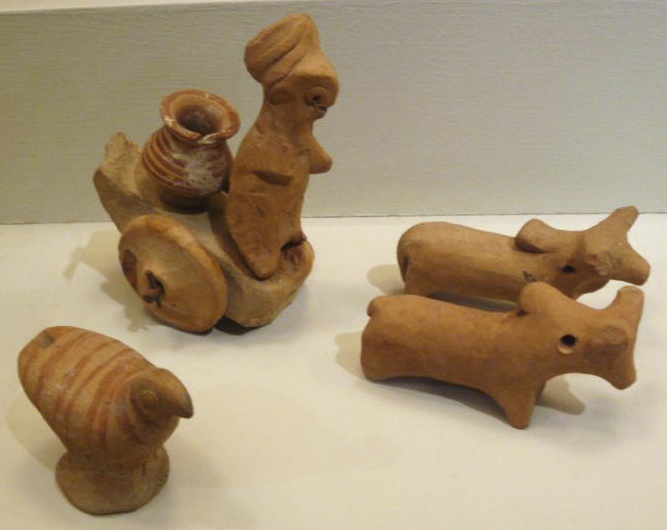
Miniature Votive Images or Toy Models from Harappa, c. 2500 BCE: The Indus River Valley Civilisation created figurines from terracotta, as well as bronze and steatite.
It is still unknown whether these figurines have religious significance.
Script and Religion
Script
Harappans are believed to have used Indus Script, a language consisting of symbols. A collection of written texts on clay and stone tablets was unearthed at Harappa, which have been carbon-dated to 3300-3200 BCE, and it contained trident-shaped, plant-like markings. This Indus Script suggests that writing developed independently in the Indus River Valley Civilisation from the script employed in Mesopotamia and Ancient Egypt.
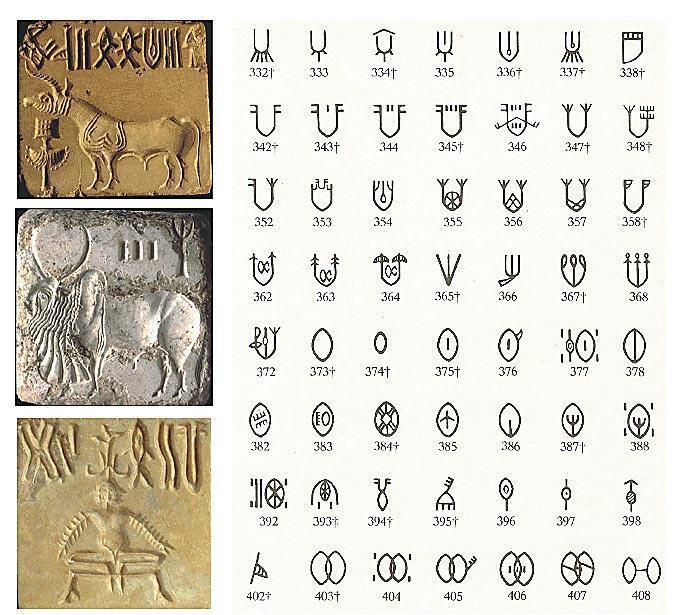
Indus Script: These ten Indus Script symbols were found on a “signboard” in the ancient city of Dholavira.
As many as 600 distinct Indus symbols have been found on seals, small tablets, ceramic pots, and more than a dozen other materials. Typical Indus inscriptions are no more than four or five characters in length, most of which are very small. The longest on a single surface, which is less than 1 inch (or 2.54 cm.) square, is 17 signs long. The characters are largely pictorial but include many abstract signs that do not appear to have changed over time.
The inscriptions are thought to have been primarily written from right to left, but it is unclear whether this script constitutes a complete language. Without a “Rosetta Stone” to use as a comparison with other writing systems, the symbols have remained indecipherable to linguists and archaeologists.
Religion
Harappan religion remains a topic of speculation. It has been widely suggested that the Harappans worshipped a mother goddess who symbolised fertility. In contrast to Egyptian and Mesopotamian civilizations, the Indus Valley Civilisation seems to have lacked any temples or palaces that would give clear evidence of religious rites or specific deities. Some Indus Valley seals show a swastika symbol, which was included in later Indian religions including Hinduism, Buddhism, and Jainism.
Many Indus Valley seals also include the forms of animals, with some depicting them being carried in processions, while others showing chimeric creations, leading scholars to speculate about the role of animals in Indus Valley religions. One seal from Mohenjo-Daro shows a half-human, half-buffalo monster attacking a tiger. This may be a reference to the Sumerian myth of a monster created by Aruru, the Sumerian earth and fertility goddess, to fight Gilgamesh, the hero of an ancient Mesopotamian epic poem. This is a further suggestion of international trade in Harappan culture.
 The “Shiva Pashupati” seal: This seal was excavated in Mohenjo-Daro and depicts a seated and possibly ithyphallic figure, surrounded by animals.
The “Shiva Pashupati” seal: This seal was excavated in Mohenjo-Daro and depicts a seated and possibly ithyphallic figure, surrounded by animals.
Trade And External Contacts
The civilization’s economy appears to have depended significantly on trade, which was facilitated by major advances in transport technology. The Harappan Civilisation may have been the first to use wheeled transport, in the form of bullock carts that are identical to those seen throughout South Asia today. It also appears they built boats and watercraft—a claim supported by archaeological discoveries of a massive, dredged canal, and what is regarded as a docking facility at the coastal city of Lothal.
The docks and canal in the ancient city of Lothal, located in modern India: Archaeological evidence suggests that the Indus River Valley Civilisation constructed boats and may have participated in an extensive maritime trade network.
Trade focused on importing raw materials to be used in Harappan city workshops, including minerals from Iran and Afghanistan, lead and copper from other parts of India, jade from China, and cedarwood floated down rivers from the Himalayas and Kashmir. Other trade goods included terracotta pots, gold, silver, metals, beads, flints for making tools, seashells, pearls, and coloured gemstones, such as lapis lazuli and turquoise.
There was an extensive maritime trade network operating between the Harappan and Mesopotamian civilizations. Harappan seals and jewellery have been found at archaeological sites in regions of Mesopotamia, which includes most of modern-day Iraq, Kuwait, and parts of Syria. Long-distance sea trade over bodies of water, such as the Arabian Sea, Red Sea and the Persian Gulf, may have become feasible with the development of plank watercraft that was equipped with a single central mast supporting a sail of woven rushes or cloth.
During 4300-3200 BCE of the Chalcolithic period, also known as the Copper Age, the Indus Valley Civilisation area shows ceramic similarities with southern Turkmenistan and northern Iran. During the Early Harappan period (about 3200-2600 BCE), cultural similarities in pottery, seals, figurines and ornaments, document caravan trade with Central Asia and the Iranian plateau.
The End of Indus Valley Civilization
The Indus Valley Civilization declined around 1800 BCE due to climate change and migration. The Civilisation eventually disappeared along with its two great cities, Mohenjo-Daro and Harappa. Harappa lends its name to the Indus Valley people because it was the civilization’s first city to be discovered by modern archaeologists.
Archaeological evidence indicates that trade with Mesopotamia, located largely in modern Iraq, seemed to have ended. The advanced drainage system and baths of the great cities were built over or blocked. Writing began to disappear and the standardised weights and measures used for trade and taxation fell out of use.
Scholars have put forth differing theories to explain the disappearance of the Harappans, including an Aryan Invasion Theory and climate change marked by overwhelming monsoons.
The Aryan Invasion Theory (c. 1800-1500 BC)
The Indus Valley Civilisation may have met its demise due to invasion. According to one theory by British archaeologist Mortimer Wheeler, a nomadic, Indo-European tribe, called the Aryans, suddenly overwhelmed and conquered the Indus River Valley.
Wheeler, who was Director-General of the Archaeological Survey of India from 1944 to 1948, posited that many unburied corpses found in the top levels of the Mohenjo-Daro archaeological site were victims of war. The theory suggested that by using horses and more advanced weapons against the peaceful Harappan people, the Aryans may have easily defeated them.
Yet shortly after Wheeler proposed his theory, other scholars dismissed it by explaining that the skeletons were not victims of invasion massacres, but rather the remains of hasty burials. Wheeler himself eventually admitted that the theory could not be proven and the skeletons indicated only a final phase of human occupation, with the decay of the city structures likely a result of it becoming uninhabited.
Later opponents of the invasion theory went so far as to state that adherents to the idea put forth in the 1940s were subtly justifying the British government’s policy of intrusion into, and subsequent colonial rule over, India.
Various elements of the Indus Civilisation are found in later cultures, suggesting the Civilisation did not disappear suddenly due to an invasion. Many scholars came to believe in an Indo-Aryan Migration theory stating that the Harappan culture was assimilated during a migration of the Aryan people into northwest India.

Aryans in India: An early 20th-century depiction of Aryan people settling in agricultural villages in India.
The Climate Change Theory (c. 1800-1500 BC)
Other scholars suggest the collapse of Harappan society resulted from climate change. Some experts believe the drying of the Saraswati River, which began around 1900 BCE, was the main cause of climate change, while others conclude that a great flood struck the area.
Any major environmental change, such as deforestation, flooding or droughts due to a river changing course, could have had disastrous effects on Harappan society, such as crop failures, starvation, and disease. Skeletal evidence suggests many people died from malaria, which is most often spread by mosquitoes. This also would have caused a breakdown in the economy and civic order within the urban areas.
Another disastrous change in the Harappan climate might have been eastward-moving monsoons or winds that bring heavy rains. Monsoons can be both helpful and detrimental to a climate, depending on whether they support or destroy vegetation and agriculture. The monsoons that came to the Indus River Valley aided the growth of agricultural surpluses, which supported the development of cities, such as Harappa. The population came to rely on seasonal monsoons rather than irrigation, and as the monsoons shifted eastward, the water supply would have dried up.
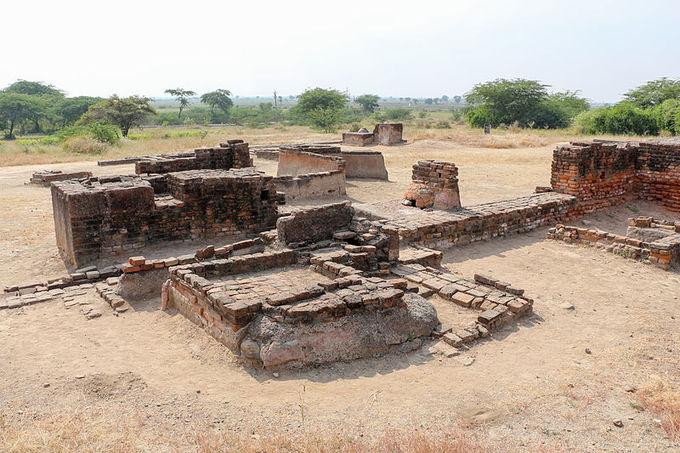 Ruins of the city of Lothal: Archaeological evidence shows that the site, which had been a major city before the downfall of the Indus Valley Civilization, continued to be
Ruins of the city of Lothal: Archaeological evidence shows that the site, which had been a major city before the downfall of the Indus Valley Civilization, continued to be
inhabited by a much smaller population after the collapse. The few people who remained in Lothal did not repair the city but lived in poorly-built houses and reed huts instead.
By 1800 BCE, the Indus Valley climate grew cooler and drier, and a tectonic event may have diverted the Ghaggar Hakra river system toward the Ganges Plain. The Harappans may have migrated toward the Ganges basin in the east, where they established villages and isolated farms.
These small communities could not produce the same agricultural surpluses to support large cities. With the reduced production of goods, there was a decline in trade with Egypt and Mesopotamia. By around 1700 BCE, most of the Indus Valley Civilisation cities had been abandoned.
Conclusion
As excavations of the sites of the Indus Valley Civilisation continue, more information will no doubt contribute to a better understanding of its history and development. Recognition of the culture's vast accomplishments and high level of technology and sophistication has been increasingly coming to light and gaining greater attention.
Scholar Jeffrey D. Long expresses the general sentiment, writing, “there is much fascination with this Civilization because of its high level of technological advancement”.
Already, the Indus Valley Civilisation is referenced as one of the three greatest of antiquity alongside Egypt and Mesopotamia, and future excavations will almost surely elevate its standing even higher.

Riya
Riya is currently an undergraduate who completed her BA honours in Pol science from the University of Delhi. Currently, she is into perspective sketching and Creative content writing. She aspires to grow in the same field.
Blogs Home
